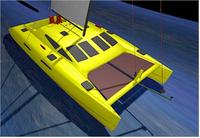 Kurt Hugheses un diseñador de MULTIHULLS que son la embarcaciones nauticas que tienen más de 2 cascos tales como catamaranes, trimaranes, etc.
Kurt Hugheses un diseñador de MULTIHULLS que son la embarcaciones nauticas que tienen más de 2 cascos tales como catamaranes, trimaranes, etc. For safety, comfort and speed, the boats in this line are as long, wide and "deep" as possible for the weight and cost. That gives a bigger, safer, more comfortable "ride" on what is really a smaller, less costly multihull. Every KHSD multihull should use as little material as possible to do its job.
I always try to find the simplest way to do whatever it is on a multi. I try to use the mass-produced products that are all around us as much as possible instead of asking builders to create new solutions for problems that are already solved.Features:
Efficient Hull Shapes
Wide Multihulls
Simple Structures
Modern Structural Strategies
No Heavy Multihulls
Pointing and Tacking
Cockpit-led Controls
Easy to Build
Fair and efficient hull shapes that are easily driven and sea kindly are the only ones found here. These are wide multihulls, allowing more safety and speed. There is no excuse for narrow multihulls anymore. All KHSD multihulls are very wide overall for their length. Wide boats are that much harder to tip over. Wide by itself is not enough, though.
The hulls themselves are as long as possible for a given amount of boat weight. Long, slender hulls give a smoother ride. Sailors won't get beaten up as badly by rough seas and the sails will work much better in bad conditions.
I stick to simple structures. There is no fluff in these designs. I have done enough boat building to know where to keep complex solutions: off of your boat. Simplicity does not mean primitive design work. It does require that the designer also be experienced both in sailing and building.
These boats have connective arrangements that use modern structural strategies, not mere mass, to achieve superior strength and stiffness. From load traces to materials choice, fiber orientation and fatigue life, the structure of these multis has been thoroughly studied. A multihull designer must be able to correctly define the loads on a boat and then properly arrange the best materials to resist those loads. Many of the strategies that I use probably will not filter down into the popular literature for years.
No heavy multihulls allowed. Keeping the weight off of a multihull promotes safety as well as speed. Less weight means less damage when grounding; it means a smaller rig is needed; it means less stress on the whole structure. These boats are light compared to others of the same size, but never at the expense of strength and stiffness. Keeping weight down depends on careful detailing. Instead of using mass to resist loads, I use the right fibers in the right place.
I prefer to use the Cylinder Mold form of construction wherever possible. (You'll need the free Adobe Acrobat Reader to view this PDF document.)
These units point! Pointing and tacking ability is not just for racers. Your survival may depend on being able to clear that cape or actually being able to short tack bareheaded up a rocky channel, or even to claw off of a lee shore in a blow.
Most of your sailing will be to weather. My entire integrated package makes KHSD multihulls more responsive and better at working to weather than any others. That package includes proper foil selection, correct balance, structural stiffness, the right sails, rigs and equipment.
Most of the boats have cockpit-led controls for ease of handling when singlehanding and safety in bad weather. Being able to accomplish everything from the safety of the cockpit during a night-time gale could be very important to your survival.
Boat speed by itself is not often a requirement for safety, though it can help you outrun a storm or get to a difficult harbor before dark. The safety in fast multis comes from what makes it fast. Multis that have a wide overall beam, light skinny hulls and efficient foils both above and below the waterline, are not only fast, but give the best ride.
No comments:
Post a Comment